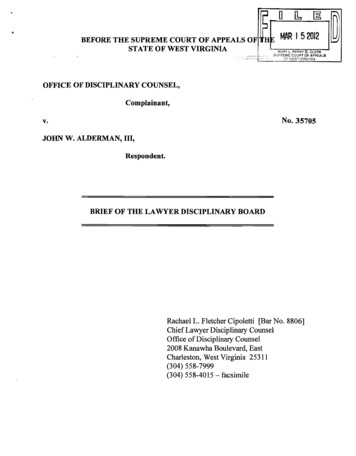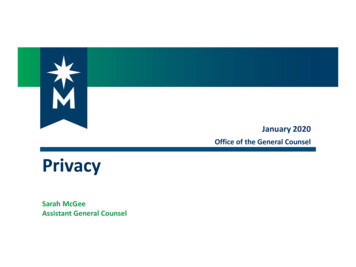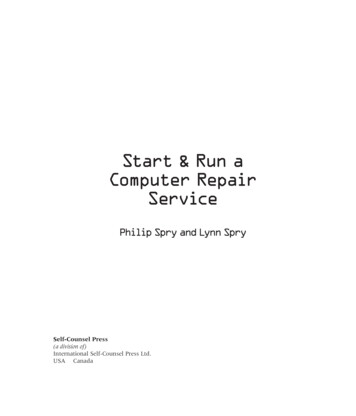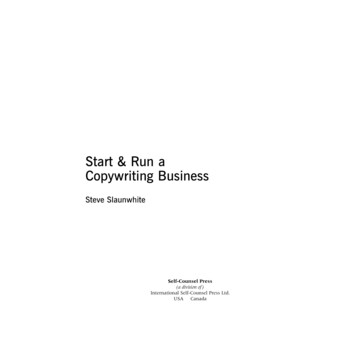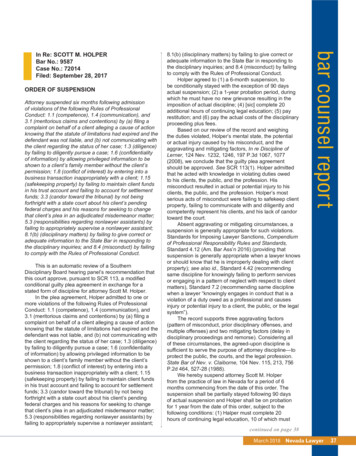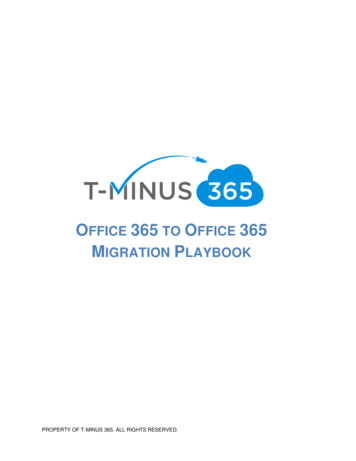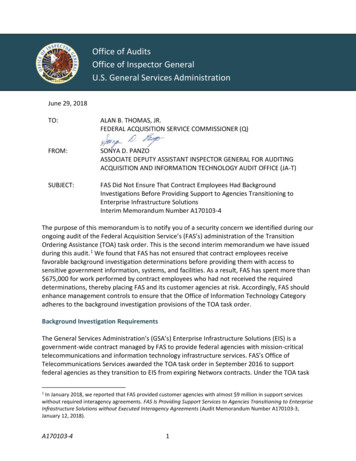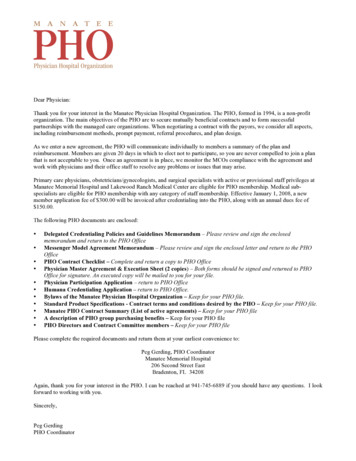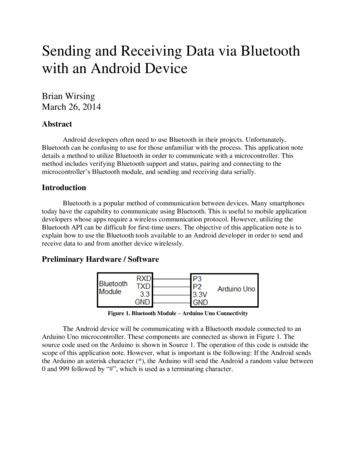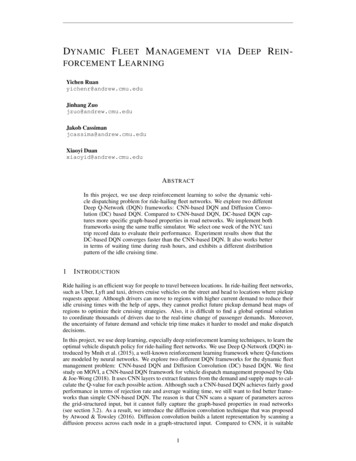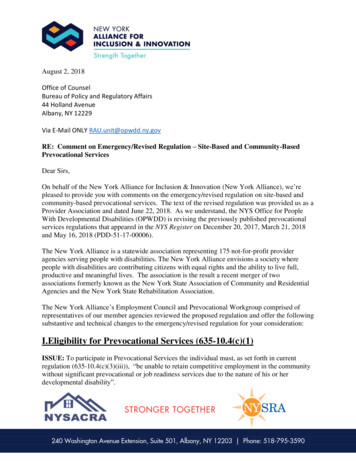
Transcription
August 2, 2018Office of CounselBureau of Policy and Regulatory Affairs44 Holland AvenueAlbany, NY 12229Via E-Mail ONLY RAU.unit@opwdd.ny.govRE: Comment on Emergency/Revised Regulation – Site-Based and Community-BasedPrevocational ServicesDear Sirs,On behalf of the New York Alliance for Inclusion & Innovation (New York Alliance), we’repleased to provide you with comments on the emergency/revised regulation on site-based andcommunity-based prevocational services. The text of the revised regulation was provided us as aProvider Association and dated June 22, 2018. As we understand, the NYS Office for PeopleWith Developmental Disabilities (OPWDD) is revising the previously published prevocationalservices regulations that appeared in the NYS Register on December 20, 2017, March 21, 2018and May 16, 2018 (PDD-51-17-00006).The New York Alliance is a statewide association representing 175 not-for-profit provideragencies serving people with disabilities. The New York Alliance envisions a society wherepeople with disabilities are contributing citizens with equal rights and the ability to live full,productive and meaningful lives. The association is the result a recent merger of twoassociations formerly known as the New York State Association of Community and ResidentialAgencies and the New York State Rehabilitation Association.The New York Alliance’s Employment Council and Prevocational Workgroup comprised ofrepresentatives of our member agencies reviewed the proposed regulation and offer the followingsubstantive and technical changes to the emergency/revised regulation for your consideration:I.Eligibility for Prevocational Services (635-10.4(c)(1)ISSUE: To participate in Prevocational Services the individual must, as set forth in currentregulation (635-10.4(c)(3)(iii)), “be unable to retain competitive employment in the communitywithout significant prevocational or job readiness services due to the nature of his or herdevelopmental disability”.
The New York Alliance raises concerns about “How” providers would document the person isunable?RECOMMENDATION: Revise the wording from “unable” to “not expected” as such languageis used in the current regulation (635-10.4(c)(1) “Prevocational Services are provided toindividuals not expected to join the general workforce within one year (excluding supportedemployment programs and pathway ”.II.Specification of Community Prevocational Services(635.10.5(ah)(7)(iii))ISSUE: Providers may now bill for Community Prevocational services delivered on behalf of anindividual while the individual is enrolled in another Medicaid service. The New York Alliancebelieves it’s important that the language now mirrors current language in the regulations/ADMfor SEMP.RECOMMENDATION: the following language change to address issues that may arise froman audit: “Allowable Community Based Prevocational services including but not limited toactual development of the community based site provided without the individual present may bedelivered”The proposed language reads as follows: “Allowable Community Based Prevocational servicesprovided without the individual present may be delivered ” (635-10.5(ah)(7)(iii))III.Site-Based Prevocational Services - Limit Group Size toMaximum of 8:1 StaffISSUE: Language was added to limit group size to a maximum of 8 to 1 staff for SITE basedprevoc. The intent to meet the federal Home and Community-Based Services (HCBS) SettingsRule and clarify the process for documentation. For instance, existing proposed language in 63510.4(c)(7) suggests group size may not exceed eight (8) individuals per one (1) staff member inSite based or Community Based Prevocational services.RECOMMENDATION: the following addition to the language: Group size may not exceedeight (8) individuals per one (1) supervising staff member in Site based or Community BasedPrevocational services.IV.Setting Limits for Group Size 635-10.4(c)(7)
ISSUE: As set forth in 635-10.4(c)(7) (For Community Based Prevocational services) only onegroup is permitted per location. Site based Prevocational services are permitted more than onegroup per location.The New York Alliance believes that setting a limit of how many groups may be used at a worksite is contrary to the intent of the OPWDD Guidance issued to providers on the transformationof Workcenters to Integrated businesses. The intent of that guidance was that the new settingsmeet the federal HCBS Settings Rule. The language as written limits the new IntegratedBusiness and the opportunities for discovery and work-based trial and may unsettle work modelsthat have already been approved by OPWDD. Further 635-10.4(c)(7)(a) as written affectscommunity based programs that meet at hub sites & in community as well as integratedbusinesses. Transportation is also an issue as some agencies pick up individuals and assemble atone site, then break into smaller groups and go out separately.As written, the regulation limits billing until groups are out of the facility. Some agencies alsohave 2 groups meet in the community so individuals can change groups to go to differentactivities without having to return to the hub first.RECOMMENDATION: A simple language change to 635-10.4(c)(7) (a) that reads: “Thenumber of groups and or size of groups that are formed to offer people community prevocationalservices is expected to meet and be in compliance with the spirit and intent of federal rules.”(Centers for Medicare and Medicaid Services Home and Community Based Settings Rule).Note: The New York Alliance is of the opinion that the rest of the sub notes remain but it’simportant to state that administrative work that would be no longer needed without the specifiedlimits as written now. Therefore, it’s wise to clarify the following: Once OPWDD approves thenumber of groups and the group size it is still understood that only one (1) supervising staff isneeded to complete the documentation for approved larger groups sizes.V.Reduction in Administrative RequestsISSUE: the Annual Prevocational Services Assessment (635-10.4(c)(6)) must be completedannually and the provider must receive prior approval for an increase in group size and or thenumber of groups.RECOMMENDATION: Put the 2 administrative tasks (Annual Assessment and groupsize/numbers) together on the same form to be completed annually, thereby reducing the numberof requests from a provider to OPWDD. This can be accomplished by striking/omitting (c) underthis section.
VI.Combine Required Assessment ProcessesISSUE: An exception to delivering site based prevoc services in a certified setting was added inthe regulation so that that the required annual assessment can be done in the community in a noncertified site.RECOMMENDATIONS: Combine the 2 required assessment processes into 1. (See commentabove). Additionally, we recommend a regulatory change to allow for one plan for“Prevocational services” not two (2) allowing for fluidity between site-based and communitybased services to occur as the individual’s goals are developed. The regulation should specifythat the activity is clearly reflected in the person’s service planVII.Allowable Service Staff Training TimeISSUE: The New York Alliance appreciates the inclusion of allowable service staff training timeas an allowable service in regulation.RECOMMENDATION: We urge OPWDD to add the following language: “staff trainingtime including but not limited to mandated OPWDD, Innovations and DSP training”VIII.OtherThe New York Alliance appreciates that “Unit of Service and Rounding Units of Service”sections in the regulation were rewritten.Additionally, we take the opportunity to inform you that we believe the issue of a 6 hour cap onState plan Medicaid waiver services severely limits the capacity of the providers to developperson centered Prevocational Services. This service should not be categorized in regulation,but should fall under the same billing process as Supported Employment.Our advocacy on this issue has been heard by Lynne Thibdeau, Assistant Director, EmploymentAnd Meaningful Community Activities. It has been shared that there is an awareness but at thistime not much can be done.The New York Alliance Employment Council thanks OPWDD for its ongoing work to offeradults with I/DD opportunities to discover, plan and develop career pathways. The changes inthe regulations effective June 18, 2018 seek to make this occur.The recommendations that the New York Alliance provides in this document seeks to further theclarity and reduction in and or duplicative administrative tasks. We appreciate the opportunity to
provide comments. Please do not hesitate to contact me at pdowse@nyalliance.org or 518-7953590 with questions you may have.Sincerely,Pat DowseVice-President of Business DevelopmentCc:Ann Hardiman, President & CEO, New York AllianceMichael Seereiter, Executive Vice-President & COO, New York AllianceLynne Thibdeau, Assistant Director, Employment and Meaningful CommunityActivities, NYS OPWDDNew York Alliance Employment Council
VII.Allowable Service Staff Training Time ISSUE: The New York Alliance appreciates the inclusion of allowable service staff training time as an allowable service in regulation. RECOMMENDATION: We urge OPWDD to add the following language: “staff training time including but not limited to mandated OPWDD, Innovations and DSP training” VIII.Other
